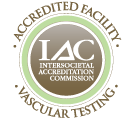VENOUS ULCERS
Venous leg ulcers are a serious result of venous disease and varicose vein issues that have been left untreated. This occurs in approximately 20% of all people suffering from varicose veins and likely a higher percentage of people who are suffering from recurrent ulcers who don’t know that it is probably a venous issue.
An ulcer (non-healing open sore) in the skin refers to a place where the normal skin covering has been wiped away and the subcutaneous tissue under the skin is exposed. Venous ulcers most commonly occur in the leg between the knee and the foot. Leaking venous valves cause high pressure and abnormal circulation in the tiny vessels of the skin. When the abnormal circulation from long-standing reflux in the superficial or other veins causes the skin to become thickened and inflamed, it can actually break down into an open sore.
A patient’s tolerance to venous ulcers can vary; they can be both painful and painless. If left without proper treatment, a venous ulcer will continue to grow larger until it encircles the leg and causes severe disability, pain, and may require amputation.
How does it happen?
When blood pools in the smaller veins next to the skin, pressure in the surrounding veins is increased. This increased pressure causes fluid to ooze out of the veins beneath the skin, resulting in swelling, thickening of the skin, and damage to the skin. When the damaged skin eventually breaks down, an ulcer is formed. The increased pressure of blood in the leg veins is due to blood pooling in the smaller veins next to the skin. Pooling occurs because the valves in the larger veins are damaged by a previous thrombosis (blood clot) causing blockage of the vein, or by weakening of the walls of the veins. As a result, the valves malfunction and become varicose veins. When the valves no longer function properly, gravity causes blood to backflow down the leg when standing. Then blood pools in the lower leg veins, increasing the pressure which, in turn, damages the surrounding tissue. Eventually, the skin breaks down and ulceration results. These malfunctioning valves may require a procedure called Endovenous Ablation, to repair the problem and restore normal pressure and blood flow to the affected area. Venous ulcers may also be caused by:
- Vein disease
- Poor circulation from narrowed arteries in the leg
- Problems with nerves that supply the skin
- Severe trauma to the leg
Treatment
Treatment begins with accurate diagnosis and treatment of the specific veins and valves that are malfunctioning. Elastic stockings or rigid leg coverings may be prescribed. Seeing a Wound Care Specialist is highly recommended. With specific diagnosis and aggressive correction, more than half of leg ulcers can be healed sufficiently to prevent recurrence.
Prevention
Early diagnosis and treatment of varicose and spider veins is essential to preventing venous ulcers. What starts as a minor aesthetic annoyance can easily escalate in to a symptomatic vein problem, and then lead to serious venous ulcers. Sclerotherapy and Endovenous Ablation procedures treating the early-stage varicose and spider veins are much easier and less invasive than the treatment venous ulcers require.



